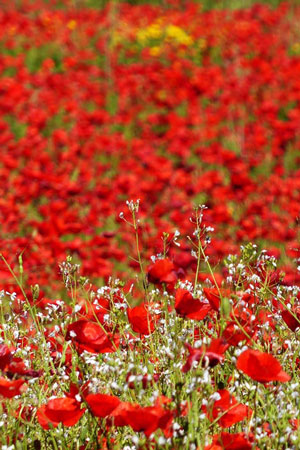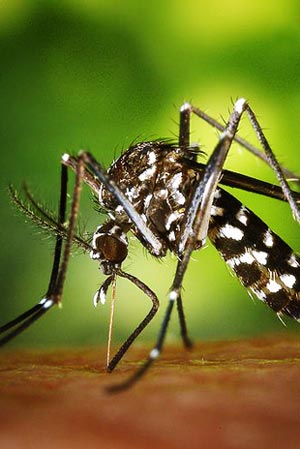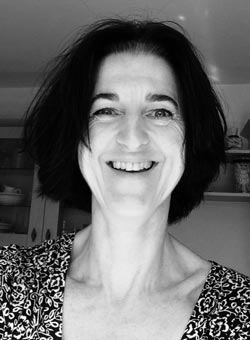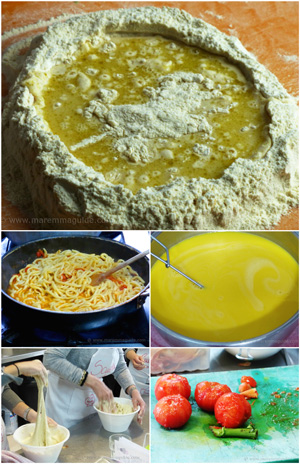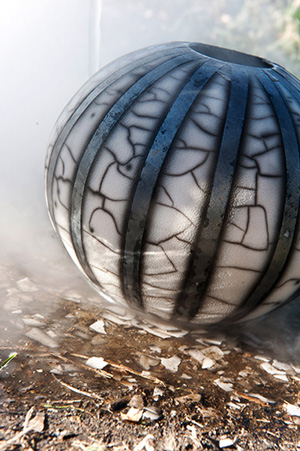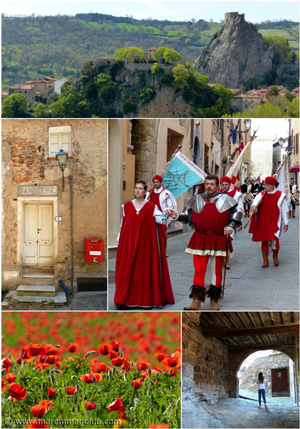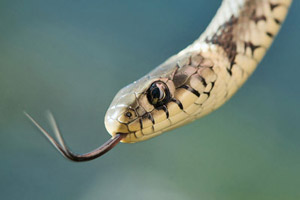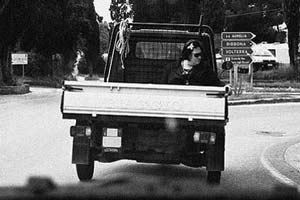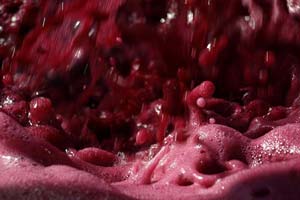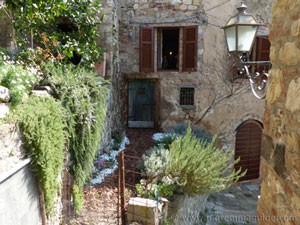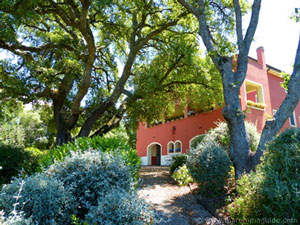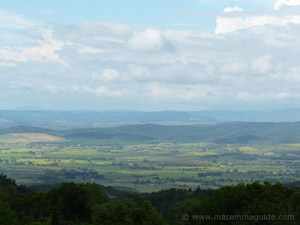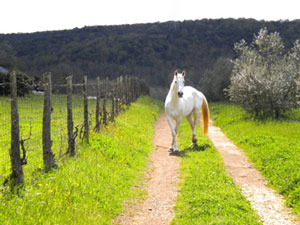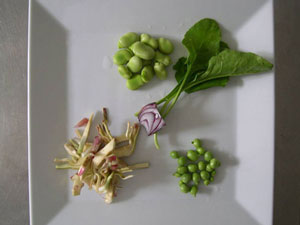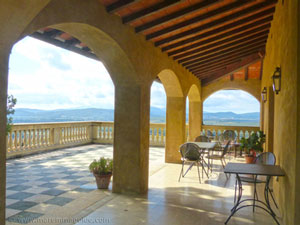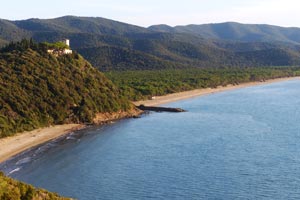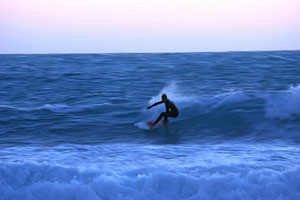The Palio races of Siena.
Pride. Passion. Bribery.
These are no gentleman's races.
Corona-virus update
The Palio races of Siena during 2020 have been cancelled due to the Corona-virus. The Palio is the lifeblood of the city in a way that it is hard to understand if you aren't born within its walls, but noone is complaining. What matters is the safety of it's residents and visitors.
The Palio races of Siena. Two of them. One in July and one in August. Magnificent spectacles of Italian tradition. Oodles of it. But. If you thought that the Palio di Siena was about pomp and pageant, you would be mistaken. Very mistaken.
For these horse races. Bareback and corrupt. In one of the world's most beautiful piazza's. Are the lifeblood of the city. Machiavellian blood that runs 600 years thick and deep.
 The Curva del Casato corner.
The Curva del Casato corner.
The Siena Palio races are, without a doubt, incredible events. The combination of Italian pride, a horse race, skill, blood and sweat. In an UNESCO World Heritage setting. Is unrepeatable.
But. To enjoy it you need to come prepared for a very long day. Spent with 60,000 plus other people. Standing for a minimum of 5 hours. Normally under a blazing sun. With no bathroom.
Don't worry if you can't get there on the day. Or, in fact, you choose not to be part of the gargantuan swell of people in town that day. It is the pre race events that you need to see. They are just as mesmerising and will tell you so much more about what the Palio means than the 90 seconds of the race itself.
Do that. And what started out as an event you went to see will turn into an experience of life. Italian life at its most open and magnificent. The coming together of men, women, and children, all with a depth of passion unfathomable to an outsider. One in which children absorb into their bloodstreams loyalty, joy and fierce proudness as if it were sugar.
An experience that will resonate within you more than you ever expect it to. Even if you did.
For the Palio di Siena isn't an event. Nor is it's history isn't tied to a 21st century initiative to attract tourists. But to an 800 year old part of Siena life that has never faltered. In a city that it at one and the same time divides, and unites.
When you are born in Siena you are part of it until you die. Not because your parents give you a Contrada scarf within hours of your first breath. That sets your allegiance for life. Even though they do.
But because it is in your blood. And the sound of the chant and songs of your Contrada is part of the rhythm of your heartbeat.
First loves will come. A wedding may follow. But nothing. Nothing. Has a stronger tie on you than your "Contrada". Not even a wife.
The Siena Palio races - find your way around

The Siena Palio 2017 dates: Sunday 2 July 2017 and 16 August 2017.
Siena Palio July 2017
The date is Sunday 2nd July 2017.
On Sunday 28 May 2017, four Contrade were chosen by lot to compete alongside those of Civette, Leocorno, Pantera, Onda, Torre, and Selva. They are: Aquila, Bruco, Giraffa, and Tartuca.
(See the rules below for why this happens.)
The race starts at 19:30.
Siena Palio 2017 August
The date is Wednesday 16 August 2017.
The seven Contrade of Chiocciola, Istrice, Oca, Onda, Selva, Torre and Valdimontone will be running. Plus three to be chosen by lot on Sunday 9 July.
And the race starts at 19:00.
Siena palio tickets
The spectator area in the centre of Piazza del Campo
First up. You don't have to purchase a ticket at all to see the Palio. Entrance to the - standing only - spectator area in the centre of the Piazza del Campo is free.
To secure a front row spot around its margin (to be absolutely clear, the margin of the central area, not the outside margin of the Piazza del Campo) from which to actually see the race, you will need to be prepared to camp out to stake one. And be prepared to stick to your ground when it fills up with around 28,000 other people and things get more than a bit concentrated and a tad pushy.

In any event, you will need to be there at the latest by 15:00.
The police start to close off access across the race track into the Piazza as the race time approaches. And the last possible entrance or exit - via Via Giovanni Duprè, the street that leads to the Contrada della Onda headquarters - is around 30 minutes before.
This bit is important
This bit is important. The centre of Piazza del Campo isn't suitable during race day for children.
It will be very crowded. With a very emotional, moving, crowd. There is nowhere to sit. Nor toilet facilities.
You'll see signs that say NO children, No pushchairs, NO WC and No dogs.
Don't want to do that?
Siena palio terrace and balcony tickets
On the days before the race, tiered wooden terraces - the "palchi" or "palchetti" as they are known - are constructed to hold around 33,000 people around the margins of the Piazza del Campo. Directly in front of the bars, restaurants, and shops that line the piazza.

Note. The bars and restaurants remain closed during the procession and race, so you won't be able to sit with a drink and watch the action from inside one of them.
Tickets for those terraces and the windows/balconies of the private apartments above them, in the "palazzi" that frame the piazza, start at around Euros 350/400,00 for standing places and go up to Euro 1,350 for a window balcony that will hold three people. This isn't a cheap day out if you want a place to sit or stand with a view.
The Comune of Siena has controlled and set the ticket prices that bar/restaurant owners around the Piazza and property owners of the flats above can charge. But there is no formal ticket office for the event. Nor can the Tourist Office obtain tickets for you.
The positive thing about the "palchi" terraces is that the seats in each "palco" area are chair-like and numbered. So you won't have to worry about jostling on a bench to keep your view.
You can find tickets online. Sold by private individuals. Some with a considerable mark-up/commission/affiliate fees added. Choose carefully.
All in all. Is it worth it?
Be aware. A window balcony doesn't guarantee you a great view. It depends where it is. And it may be standing, not sitting, room only. With, or without, access to a bathroom and/or drinking water supplied.
If you are going to, note that the action happens at the race starting line - the "Mossa" location. To the left of the Fonte Gaia fountain. And on the two acute corners at the end of the straight length in front of Palazzo del Pubblico. The eastern Curva di San Martino and the south-east Curva del Casato.
Be aware again that, if you purchase a window/balcony or "palchi" seat in the San Martino corner of the piazza, you will be in full sun during the whole afternoon. At best, right-up until the moment of the race itself.
Sometimes, just sometimes... last minute bargains
A couple of years ago the Siena authorities announced a last minute sale - that took place on the morning before the race - of a couple of handfuls of terrace tickets at less than half of their original starting price, when the first became available the year before!
So if you are already in town and hear a whisper - or if I do, I'll post a notice on my What's New page to tell you - you might just be lucky. It will mean queuing for a chance, but what a tale to tell that would be if you were lucky to grab a couple.
Another place to check is with a lady in the know, local Katya in her blog mapitout-siena.com.
Terrace tickets on pre-race trial days start at around Euro 50,00. If you purchase way in advance.
Siena palio tours
If you think you have found a Siena palio tour that gets you a seat at the race. Often after a morning's tour of the city. I have to say one of the worst days to "see" the city with so many other people crowding the streets and many of them with restricted access. With lunch included in an osteria/restaurant. Do check the wording carefully.
I have yet to find one that does more than "give you time" after lunch to make your way into the free public Piazza del Campo spectator area in the centre.
Siena Palio history
To find the origin of the Palio di Siena you have to go back in time to Siena of the late middle ages. A time of games. Dirty games. Played out on an impressive board. The Piazza del Campo.
Siena, a city of games
The Sienese of the day liked a game. Or two. Or three. They played "Mazzascudo" with maces and shields, and "Giorgiani" with blunt instruments. And jousted. Beating the hell out of each other at every opportunity.
An approach they similarly adopted with their much loved "Giuoco delle Pugna". A rough kind of boxing, with as many men in the "ring" as possible.
Until, as was their want, it all started to get out of hand with improvised implements and what else could be found to hand. And it all got a bit too bloody. Even for the town's Bishop. Who had to step in, literally, amongst the throes of battle to get it to stop.
When it got too gory
"Pugna" was banned in 1324. But the gore continued in the Piazza with regular bull fighting matches that appeared to have satiated the major part of Sienese appetite for blood spilling.
All awhile the Contrade began organising city-wide races called "palii alla lunga". Long palio races.
When it all got too bloody again
But in 1590, the Grand Duke of Tuscany had had his gut full of the sight of bullfighting. And outlawed it. Once and for all.
With them gone, the public races moved into the Piazza. Bareback buffalo ones called "bufalate" and, similarly, bareback donkey ones called "asinate".
The first bareback palio horse race in the Piazza del Campo - the "palio alla tonda", palio in the round - took place in 1633.
Officially the last to survive... but
Of all the Contrade 14th century games and races, the only one that survives today is the Palio. Although it has to be said that a few instances of what can only be best described as a return match of "Pugna" have happened between Contrade on occasions!
Notably and somewhat ironically, was the instance at the announcement of the winner of the extraordinary Palio della Pace. The Palio of Peace, run on 20 August 1945 to celebrate the end of the Second World War. When all hell broke loose between the Contrade of Drago and Bruco.
In short, the Contrada di Drago was declared the winne of the Palio, but the noble Contrada del Bruco refused to accept the outcome. An humongous fist fight broke out: the biggest the city has seen in living memory. Tales of it are still told today by those who witnessed it! During which the "contradaioli" of Bruco ripped the winners silk Palio to shreds.
It all ended in court. The Nobile Contrada del Bruco was ordered to pay compensation to the Contrada del Drago. And to commission the painting of a new Palio to be given to the Contrada del Drago to replace the one destroyed.
It won't come as a surprise to learn then that the two are arch enemies. Nor that, nearly 700 years after it was banned, "Pugna" is still running in the blood of the Sienese when things get heated!
Not for money, for the "Palio"
Money is involved in the Palio. But it isn't the prize.
The "pallium" or "drappelloni", the hand-painted silk banner, simply and best known as "il Palio", is what it is all about. To hold it high. In the face of your enemy Contrade.
The Terzieri and Contrade - the districts and their neighbourhoods
First you belong to a Contrada. Then you belong to Siena. That is life if you are born in Siena or the one of the Contrada's territories. At the one time the Contrade divide and unite the City.
The division of Siena goes back to the 1440's when its districts were separately governed.
And this bit is important. Battles were fought. Over boundary disputes. And insults were hurled. For which Contrade have remained bitter enemies to this day. Remember that. It is fundamental to the preparations, the strategies decided, the songs sung and the actions taken on race day.
PALIO - Clip 7 from Archimedia Productions on Vimeo.
But money runs deeper than blood for one man
Loyalty to and support of your Contrada is everything in Siena. Except in July and August for one man. The jockey.
When he decides that his destiny is to wear the silks, from the moment he dons his colours, no one will consider him "pure". Although he may well still feel his allegiance to his Contrade as strong as ever - and who could imagine that it could be any other way, having been born into and grown-up within one - his will play his hand to the maximum for the hand that feeds him on race day.
But. Even then, his loyalty to his brought allegiance, warranted or not, will always be questioned.
Because he can be brought again. Bribed. But not simply to loose. But to assist or hinder another Contrada. It all comes down to allies and enemies.
The Terzi or Terzieri

There are three "Terzi" - districts: the Terzo di Citta, the Terzo di San Martino, and the Terzo di Camollia.
In turn, they are divided into what were the independently governed areas called the "Contrade". The quarters, wards, or neighbourhoods.
In Italian, singular "Contrada", plural "Contrade".
And residents of a Contrada are known as "contradaioli."
Each Contrada not only represents a physical part of town, but historically professions and trades within the city.
Once there were more, many more
Seventeen of the Contrade survive today. But once there were many more. Fifty-nine in fact.
But by the 17th century, through disorganisation and poor participation in civic life, they had begun to die out and their number dwindle.
In 1729, when there were 23, the number of quarters was reduced to its figure today of 17. With the abolition of 6 Contrade: Gallo (Rooster), Leone (Lion), Orso (Bear), Quercia (Oak), Spandaforte, and Vipera (Viper).
Gallo was divided between Civetta, Oca and Selva. Leone went to Istrice. Orso to Covetta. Quercia to Chiocciola. Spadaforte divided between Leocorno and Torre. And Torre took Vipera.
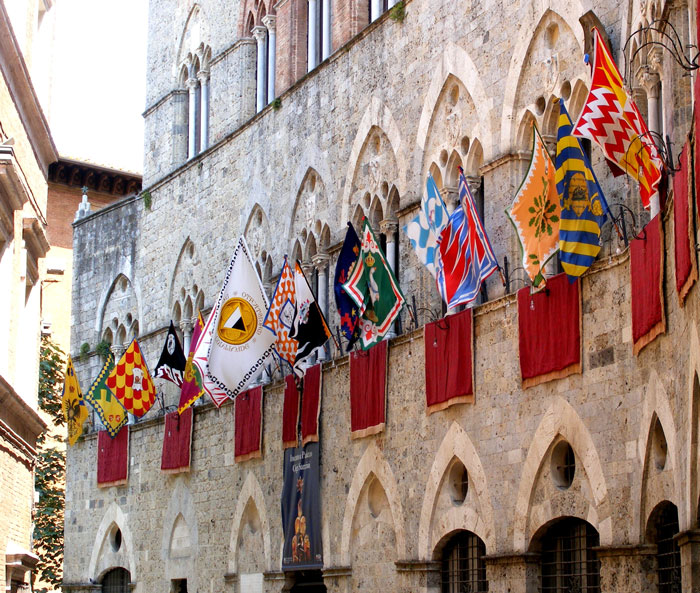
But they haven't been forgotten and you can still spot them... if you look
When the costumed parade enters the Piazza del Campo, the order of the proceedings is always the same.
After the ten Contrade running in the race each enter the Piazza with their jockey astride a large horse, the "soprallasso", followed by their horse for the race. There will follow a double row of pages carrying garlands to delineate those Contrade from the next seven Contrade that aren't participating this time.
It is then, between the last of the seven Contrade and the archers - 20 of them - that you can spot six "cavalieri" (horsemen) and their grooms. From the six Contrade that are no more.
Terzo di Città
The Terzo di Città, located in the south-west, highest and most ancient part of the city, is home to the Contrade of:
Aquila (Eagle) - the notaries,
Chiocciola (Snail) - the terracotta artisans,
Onda (Wave) - the carpenters,
Pantera (Panther) - the pharmacists and grocers
Selva (Forest) - the weavers and military archers, and
Tartuca (Tortoise) - the sculptors.
 The Siena palio banner of the Contrada dell'Onda by Rabe!
The Siena palio banner of the Contrada dell'Onda by Rabe!

Nobile Contrada dell'Aquila

Contrada della Chiocciola

Contrada Capitana dell'Onda

Contrada della Pantera

Contrada della Selva

Contrada della Tartuca
Noble Aquila territory. Allied to Civetta and Drago but enemies of Pantera.



The Terzo di Camollia
The Terzo di Camollia occupies the northern part of the city and takes its name from Siena's northern city gate, the Porta Camollia. Which, in the middle ages, it guarded heavily against murderous attacks from Siena's arch enemy, Firenze.
Camollia is home to six Contrade:
Bruco (Caterpillar) - the silk merchants,
Drago (Dragon) - the bankers,
Giraffa (Giraffe) - the painters,
Istrice (Crested Porcupine) - the blacksmiths,
Lupa (She-wolf ) - the bakers, and
Oca (Goose ) - the dyers.
 Contrada della Lupa by Rabe!
Contrada della Lupa by Rabe!

Nobile Contrada del Bruco

Contrada del Drago

Contrada Imperiale della Giraffa

Contrada Sovrana dell'Istrice

Contrada della Lupa

Nobile Contrada dell'Oca
The Terzo di San Martino
The Terzo di San Martino is located in the south-eastern part of the city and developed around Tuscany's Via Francigena route as it passed through the city. It is home to Siena's only castle and five Contrade:
Civetta (Little Owl) - the shoemakers,
Leocorno (Unicorn) - the goldsmiths,
Nicchio (Seashell) - the potters,
Torre (Tower) - the woolcombers, and
Valdimontone - also known in its shortened name of Montone (Valley of the Ram) - the tailors.
 Contrada di Valdimontone by Rale!
Contrada di Valdimontone by Rale!

Contrada Priora della Civetta

Contrada del Leocorno

Nobile Contrada del Nicchio

Contrada della Torre

Contrada di Valdimontone
Civetta getting ready for the Contrada dinner.

Leocorno territory

Who is the best turned-out? - The honoured Masgalano prize
If you didn't already know it, appearance is all in Italy. "La bella figura". And it applies as much to everyday life as it does to high days. Including, in Siena, Il Palio.
Each year a prize is awarded to the Contrada who, during both of the historical "Corteo storica" parades, present themselves with the most elegance, dignity of bearing, and coordination. In truth, it was re-introduced in 1950 to help maintain and restore a proper sense of pride and dignity during the parade.
What began as around a kilo in weight of silver trays and bowls depicting an aspect of Sienese life, now also include sculptures by renown international artists.
The name Masgalano comes from the Spanish, "mas galant". "Mas" meaning "piu" in Italian, "more" in English. And "galant" meaning "elegante", elegant in English.
The Contrada with the most Masgalani victories is that of Giraffa, with 10. Followed by Chiocciola with 9, and Lupa and Nicchio both with 8. The two Contrade that have won the least amount of times are Oca and Valdimontone, with one win each.
The 2017 prize has been donated by the lions Club of Siena and was created by Florentine goldsmith Paolo Penko.
You can see images of them all - dating back to 1950 - here in the Siena palio website, ilpalio.org. Click on either the names of each Contrada, or their shield to see the Masgalani they have won.
Since 1973, there has also been a mini Masgalano, for the children of the 17 districts. Called the "La Manifestazione Giovani Alfieri e Tamburini".
The Siena Palio race rules
Only 10 Contrade run the race
Only 10 Contrade can run in each palio race. Why?
Because, before 1729, when everybody ran it was a blood bath with too many incidents. So now, a maximum of 10 can race in any one palio.
Who they are is decided in two ways. The first seven are always those Contrade that didn't run in the preceding palio. Unless. Unless one (or more) is under suspension for a breach of rules etc.
The remaining three Contrade are randomly selected by lot from the ten that ran in the race before. See below.
Censures, disapprovals and disqualifications
The regulations of the Palio allow for "Censura' Deplorableness e Qualification" - censures, disapprovals and disqualifications of Contrade.
A censure has a shelf life of 4 palios and 4 of them equate to one disapproval.
A disapproval has a life of 9 palios and if a Contrade happens to be unfortunate enough to receive 3, it equals a disqualification for the next palio.
A disqualification has a life of 10 years and its application can extend to one or more palios over that time.
Similar regulations apply to the jockeys.
And boy, oh boy, have they been applied! Most jockey disqualifications are a consequence of what they get up to during "la mossa". The unique to the palio, beginning of the race. Two jockeys, one in 1996 and one in 1997, were each given a disqualification that lasted for 20 "palii".
The palio jockeys - "fantini"
Each of the ten palio jockeys - known as "fantini" - must be named by their respective Contrada on the morning of the race. After that, the jockey cannot be changed or substituted.
No matter what the circumstances; ill health, death (heaven forbid!), or anything.
"Cavollo scosso"
Needed at the beginning, but not necessarily at end. Without its named jockey at the beginning of the race the Contrada cannot participate.
But. If a jockey falls - and they do - and the horse continues without him, the horse he can still go on to win for the Contrada. A "cavollo scosso" win. And they do. The win also goes down against the name of the jockey too. Which some claim to be unfair on the other jockeys who manged to stay on their horses!
The horses

The race used to be run by thoroughbreds, but now only mixed breed horses are allowed to run. The decision was taken as mixed breeds - particularly a robust breed of horse from Sardinia - are better suited to the very noisy and populated palio scenario. The conditions of the track and its bends.
Once a horse has been allocated to a Contrada - see below for how - if it has to be withdrawn, for example from an injury during the trials, illness, or because it is not considered in the horses best interests to let him race. Or, if the unthinkable happens and it has (to the Contrada Tartuca in 1806) and the horse dies the night before.
Then so is its Contrada from the race. No substitutions are allowed.
The starting-rope line-up
The order of the horses at the "Mossa" starting line is determined by a "fiasca", a sphere. Ten balls, each one bearing the Contrada colours of the horses are put into a sphere connected to a cylinder by a valve. The cylinder has 10 windows. Closed. The balls are swirled in the sphere. Tipped into the cylinder. The valve closed. The cylinder removed.
And, when the race is ready - and never before - the windows are opened to reveal the exact order of the running of the horses. The order is written down on a piece of paper which is given directly to the Commander of the Municipal Police. Who, in turn, carrying it high in the air, walks and gives it to the "mossiere" (starter) waiting, smartly suited, at the starting line.
Three laps
Three laps - clockwise - round the piazza are required to finish.
Sticks and stones may break my bones...
Practically anything goes. Although stones aren't thrown, sticks are used in this race. The "nerbi" - dried bulls' hide jockey whips. To hit not only your own horse, but also your opponent. Especially. Especially if he is riding for an enemy Contrada.
All legal. Along with shoving and pulling and...
Bribery
It is legal to bribe the jockeys. Full stop! And the competing Contrade do. What else can I say.
This is a mans race
It isn't written. But this is a mans race. Only one woman has ever raced in the Palio di Siena. The proper Palio. Her Palio nickname was Diavola. The female devil. But she was also known as "Rompicollo", which in Italian means daredevil or breakneck. Rosanna Bonelli was born in Siena on 10 August 1934.
She didn't win. But, boy, as her nicknames suggest, she had guts.
The race track
The racetrack around the stunning Piazza del Campo is prepared during the week before the race. The City authorities pay for tons of earth and fine volcanic tufa sand to be imported and laid. Earth first. Sand on top. Which is then cleared, cleaned, compacted and inspected before each of the trials begin. And again, before the race itself.
In between times, you get to walk and dine out all over it!

There are two dangerous corners of the track. The Curva di San Martino and the Curva del Casato. The first has padded crash barriers (mattresses!!) to help protect the jockeys and horses from injury. But they still happen.

The Curva di San Martino is the more dangerous. Because the horses arrive there at full pace. Because the angle is acute. And because it slopes down to beyond the entrance to Palazzo Pubblico, before rising again to the Curva del Casato.

It was my first time at the Palio and I just pointed my camera and kept the shutter button down. So some of my shots missed a lot of the action and or were blurred! Next time I'll read-up on my camera's manual first and point and shoot in manual!
Even if you have that perfect shot in focus... expect a non intentional nudge as others try to take it too!
Or. I might just watch it instead. It isn't the same through a camera lens. And when I did I was bowled over with how close the horses and their jockey get to the spectators in the front row. Me! I had to lean back a couple of times. Magic moments!

The starting line
The starting line at the Palio isn't just one line, but two.
Two ropes. One across the track in front of the horses and their riders. The "canapo". And a shorter one across the track behind them.
The "canapo" will be dropped by a mechanism in the control of one man, the "mossiere" (starter). But is isn't him nor a pistol that determines when he drops that rope.
It is another man. A man with intent and money in his pockets. See "Nine men in, one man out" below.
The events leading up to race day
You don't have to be in Siena on Palio day to experience "palio". Take a trip into the city on a day before, walk around and watch. And you will leave with a taste of what it is all about.

L'estrazione delle Contrade
To the sound of trumpets and the whole city gathered, the beautiful Renaissance "trifore" windows on the first floor of Palazzo Pubblico will be opened. One by one.
And, normally, the flags of the three selected Contrade will be hung out to join those of the 10 Contrade that didn't run in the previous palio and whom have automatic entry into the next palio (suspensions allowing!). To the sound of much joy from below. Until the last. When the hope of your Contrada participating, if their flag hasn't yet been put out, is lost.
But, the Estrazione delle Contrade for July 2017 comprised of four Contrade, because the Contrada Valdimontone had been excluded due to a previous disqualification.
The first to be chosen was the contrada L'Aquila. The 2nd Tartuca, the 3rd Giraffa, and lastly, the contrada Bruco. They join Civetta, Leocorno, Onda, Pantera, Selva and Torre.
NOTE. There were two enemy couples in the race: Aquila and Pantera, and Civetta and Leocorno.
The August 2017 line-up will, therefore, include the Contrade of Chiocciola, Istrice, Oca, Onda, Selva, Torre and Valdimontone. The "estrazione" for each August Palio is made on the Sunday after the July palio, during the "Corteo".

The deals and pacts begin
You don't get to see this part of Siena's "Il Palio", but it goes on behind closed doors in whispers and in secret meetings. From the moment the 10 running Contrade are known.
Allies against enemies.

The "prove di addestramento" - horse training tests
Training tests - called the "prove di addestramento" - take place with all of the horses proposed by stables as suitable to run in the palio. These events aren't open to the public.
July race
From 05:00 to around 07:30 on the morning of June 28th.
August race
From 05:00 to around 08:00 on the morning of August 12th.
At 07:00 in the morning on the next day (June 29 and August 13), the horses that have made it through the tests and are going to participate in the palio trials, are presented in Piazza del Campo to the dignitaries and public of Siena.
The "batterie" horse selection tests in Piazza del Campo
Having first been confirmed as fit to participate by veterinarians, the horses are gathered into groups - "batterie" of between 5 to 7 horses. And are raced around the Piazza del Campo track three times.
These you can watch from the Piazza.
July race
09:00 29 June.
August race
09:00 on 13 August.
Those deemed adapted to the conditions of the track are presented to the ten Captains of the Contrade participating in that Palio and the Mayor. Who then, together, select just 10 horses.
The bodyguards
The bodyguards. The men in blue. Not for the jockeys, but for the horses.
Each Contrada appoints a "Barbaresco". A Contrada jockey who, along with a vet, blacksmith and chosen members of the Contrada, will care for the horse from the moment of its allocation to the Contrada until after the race.
But it is the "Barbaresco" that will, from the moment he walks his horse - his "barbero" - away from the Piazza del Campo during "la tratta", stay with him all 24 hours of every day, right up to the race.
Including bringing him into the Piazza del Campo for the race.
For the jockey doesn't do that. He enters the Piazza astride another horse, a horse selected for the parade. A "soprallasso" horse.
"La tratta" - the selection of the horses
At lunchtime that same day, in front of the stunning Palazzo Publico in Piazza del Campo, the matching of horses to the Contrade takes place.
By drawn lot.
Which is how some horses have won for multiple Contrade.
PALIO - Clip 6 from Archimedia Productions on Vimeo.
July race
12:00 29 June.
August race
13:00 on 13 August.
From each Contrada, the Barbaresco leads the horse chosen for them the to the security of the Contrada stables. Surrounded and followed by the whole of the Contrada.

Catching the jockey
It is then that the Capitano of the Contrada makes his calls. To the jockeys of his choice for the horse he has been allotted.
He has to be quick. He has to already know in his mind what his strategy is going to be. Based on his and the other allocations. To block his enemy. Or to go all out for the win.
And he will want his first pick of the best "fantini" for the job. The ones that know the horse well. Have stabled and ridden it in the past.
So he makes the calls. To secure their services. Before another Capitano does. But he has to be the first to make that phone ring.
But the horse won't know which of the jockeys secured by the Capitano will be on his back on race day. Not yet.
The division of families
It is normally around this time, when the intensity of the competitiveness between Contrade is heating up, especially now that they know which horse they are running with and who their jockeys are, that some families with divide for the next few days.
Husbands or wives with different allegiances and horses in the race, go their separate ways until it is all over.
Palio is so strong, it breaches marital ties.
 Piazza Salimbeni, during the Palio races of Siena.
Piazza Salimbeni, during the Palio races of Siena.
 Palazzo Tantucci.
Palazzo Tantucci.
 Palazzo Spanocchi.
Palazzo Spanocchi.
The "provi" - trial races
The track tufo and sand goes down and the trials begin.
There are six in all. Starting on the evening of "la tratta" and finishing on the morning of the Palio. All of which are open to the public to view.
The dates and times for both races:
July race
29 June at 19.45
30 June 09:00 and 19:45
1 July at 09:00. And at 19:45 (during the dress rehearsal).
The last "prova" on 2 July is at 09:00.
August race
13 August at 19.15
14 August 09:00 and 19:15
15 August 09:00. And at 19:15 (during the dress rehearsal).
The last "prova" on 16 August is at 09:00.
There will still be crowds, but ticket prices are lower than on palio day. Prices start at around Euro 50 for a stand seat.
Entrance to the centre of Piazza del Campo is still free, but you will need to make sure you are there in ample time before each trial starts. By 08:40 for the morning trials and 30 minutes before the start of the evening trails. Once the police have finished clearing the track to declare it "pulito" (clean and fit for use), you won't be able to gain access.
There is no less tradition on trial days as on the day of the palio itself. If you cannot make the Palio. Or have chosen not to be there amongst so many people. The "provi" won't leave you without a sense of what it is all about.
In fact, it is on those days that you should go. To really have a chance of understanding. What it is that runs through the blood of every man woman and child born there.
Each horse is led by its Barbaresco from its stables, into Piazza del Campo by a swell of Contrada members. Singing. And then by the Barbaresco and Capitano alone into the courtyard within the heart of Palazzo Pubblico.
The dress rehearsal and the charge of the Carabinieri with swords
Ready and waiting. Siena's Carabinieri who will lead a mounted charge - called the "carica" - around the race track at the beginning of the dress rehearsal.
One lap in formation at walking pace. The second at a gallop with swords held high.
 Photo by Franca Nerelli.
Photo by Franca Nerelli.
Although for some reason during the Prova Generale on the 1 July 2017 - I think it was because proceedings were running behind that afternoon (no one seemed to be in a hurry to leave the track even with the cleaners and police doing the clockwise round to clean and secure its entrances and exits) - the Carabineri didn't appear.
July race
19:45 on 2 July
August race
19:15 on 16 August.
The rehearsal lasts for about an hour on the day before the race. But starts with the same explosive charge as the real thing the next day (lit to go off at 18:45 on 2 July and 18:30 on 16 August).
The horses and their jockeys will, this time, line up between the starting line ropes according to the original lot number of the horses in the "tratta" draw. Notwithstanding that there is one more, final trial race to run, this one is the last of the races that matter.
The procession leaves the Cortile del Podesta at 19:45 in July and 19:30 in August.
The Contrade dinners
Two Contrade dinners fill Siena's streets at night. One before the race. And one after.
The "Cena della Prova Generale"
The night before dinners - the "cena della Prova Generale" - in the open air in the streets of each of the City of Siena's Contrade, are quite a sight.
By asking - at a Contrada headquarters or one of the Contrada members preparing the tables during that afternoon - you might, if you are lucky, be able to get a seat at one of the long tables. Now wouldn't that be a thing to be part of!
The Contrada Capitana dell'Onda dinner
The dinner tables within the Capitana dell Onda appropriately look just like a wave and are very, very long. Stretching the length of an entire street, Via Giovanni Duprè.



Some of the Contrade even have the menu up in the doorway of their HQ. Expect an antipasto, a pasta dish, a roast (usually pork) with potatoes and something like a creme caramel. All with water and wine, of course!
If you take a walk around you'll even get to see the hustle and bustle going on inside the kitchens and cellars that line the streets. With men cutting and carrying tons of bread and a general discourse in the air about what to do and when!
Not only for the unique opportunity to witness the inner workings of a Contrada, but to be part of the build-up of speeches, songs and air thick with well wishes to bolster the Contrada for the day to come.
And. To know that when the Contrada Capitano (Captain) and his close conspirators get up to leave the event. That they do so to join in town the counterparts of their allied Contrade to finalise the deals.
The ones that will secure - unless a riderless horse, or the treachery of a jockey decides otherwise - the outcome of the Palio.
You'll have no idea until you are sat down at one of the long trestle tables that will stretch the length of the street, who you are next or opposite to. But that is part of the fun. It could be another visitor. The painter of that year's palio. Or a very loud little "contradaioli"!
Expect to pay around Euro 50,00 per person for the experience.

The "Festa della Vittoria"
The second set of outdoor Contrade dinners are the Contrade victorious dinners. And these don't happen on the night of the race. But in the subsequent months: September and October.
Massive affairs, with caterers called in so that everyone in the Contrada can enjoy the event rather than be tending to a stove in the kitchen or serving, they involve the whole Contrada community. And their guests.
Pride of place of honour isn't the jockey, but the horse. Who joins the revelers at the table.
You will need an invitation to attend one of these.
Race Day
The last "provaccia"
The last trial race, but not an important one.
For all was decided after the "prova generale" and the jockey settled on before the dinner that followed. At which the chosen jockey sat at the table of honour with the Contrada elders.
Which is why it is a quieter event, much less well attended by members of the Contrade. All is done and set. Time is better spent doing other things.
That is, unless. Unless. The weather, as for the 2 July 2017 race, stopped three of the "prove" from taking place. In which case, this trial will count in the decision.
After this race, the Contrade Capitani and fantini (Captains and jockeys) present themselves in the city's Comune to register their participation and present the silks that the jockey will wear (his jacket, the "giubbetto").
Once the jockey's name has been entered into the register, the Contrade cannot, under any circumstances, change their designated "fantino".
July race
2 July is at 09:00.
August race
16 August is at 09:00.
The blessing of the horses and jockeys
Race day afternoon inside the Contrada's church, where it feels as though every one of its residents has squeezed in, and they probably have, the Contrada church priest will give the benediction blessing to both man and animal.
 Inside the Contrada Priora della Civetta church.
Inside the Contrada Priora della Civetta church.
The ritual, which hasn't changed for centuries, not even by one word, always ends with the blessing, "Vai e torna vincitore!" Go and return as the victor!
Tell your kids that, if the horse poops during this ceremony, it is considered a huge sign of luck!
July race
15:30 on 2 July
August race
13:00 on 16 August.
The Corteo Historico - the historic costumed procession
The medieval costumed "Corteo Storico" procession starts from the courtyard of the Palazzo del Governo in the Piazza del Duomo (cathedral square), and winds its way through the city before entering the Piazza del Campo.

It is a long affair. That will take two hours.
It ends, when all of the dignitaries are seated on their tiered terrace in front of the Palazzo Publico.
At which point there is a display of flag waving by the Sbandierei of all the 17 Contrade. A wonderful sight for the sense. Flashes of colour combined with incredible skill, all accompanied by the beating of drums, blasts of trumpets, and the ringing of the tower bell at the very top of the Palazzo tower - the Mangia. As well as that of the little "Martinella" bell on the "carroccio" oxen-pulled chariot that carried the dignitaries into the piazza.
Towards the end of the display, the "drappellone" for that day's palio is hoisted onto the "Palco dei Giudici" - the judges balcony.
And the race begins.
July race
The procession leaves the Palazzo del Governo at 16:30 and enters the Piazza del Campo at 17:20.
August race
The procession leaves the Palazzo del Governo at 15:50 and enters the Piazza del Campo at 16:50.
NOTE that if you want to watch the race from the spectator area, you will have to be inside the centre of the Piazza del Campo before the procession arrives. The last access point to be closed is Via Giovanni Dupre, to the right of the Palazzo Pubblico.
Once the gates into the spectacor area are closed and sealed at their bases with tufa sand, no one will be able to enter or leave until the whole thing is over.
The Palio di Siena
- the horse race like no other in the world
This isn't a gentleman's race. And the start isn't like any other horse race you will have witnessed.
Expect menacing looks between the jockeys.
Expect false starts. Sometimes a lot. And a long start. It is no straightforward thing. It depends on the deals done. (The July 2017 race took more than an hour to start. See below.)
Expect the jockey's sticks to be used not only their horse but their opponents too.
And for them to fall. Under hooves, between horses and up against barriers.
And expect there to be no breathing room for man nor horse around the winner.
For a cohort of the crowd in the winning colours to go jumping mad. To scream. To hug each other and openly cry in a way that only emotional Italians do. A crowds' reaction to goals at a major football match doesn't come close to the highly charged response to the Palio in Siena.
And.
Witness something else. The full out celebration of a Contrada if it's enemy fails to win. Just as vehemently. Just as loudly. Nothing discrete about it. Even if they haven't won the Palio. Because a losing enemy counts as a success nearly as much as a Palio victory. No matter how it came about.
This is Machievellian Tuscany.
Who would want to be a Siena Palio jockey?
 Photo by Franca Nerelli
Photo by Franca Nerelli
All jockeys are deemed corruptible. Therefore considered, even if not, to be corrupt.
Loved only by their Contrada if they win. Hated by their enemies.
There is no love lost between "enemy" Contrade. But nor is there between a Contrada and its jockey if he loses. For he will be suspected of having been brought off. And treated as such. Even by his friends from birth with whom he went to nursery school and grew-up side by side with. In each others houses.
There are infamous times not so long ago, when he would have been set upon and beaten, kicked. Chased to where he had taken refuge. Given police protection. And the followed when they had gone to be attacked.
Battle-scarred veterans will tell you it is part of the game.
PALIO - Clip 8 from Archimedia Productions on Vimeo.
Race time
An explosive charge is detonated in the Piazza del Campo to announce to all that the race is about to begin.
The July race race time is 19:30.
The August race time is 19:00.
Nine men in, one man out: "la mossa"

The start line is located just to the left of one of the 11 streets that enter Piazza del Campo, the Costarella dei Bariere. It is here that "La mossa", something that doesn't happen in any other horse race in the world, takes place.
Nine men in, one man out.
Once the horses have been warmed-up along the track behind the starting line, the jockeys take it in turn, according to the results of the "fiasca", to take their place behind the "canapo". And try to keep their positions as best they can.
All but the last of them. Number 10. The "rincorsa". For he stays well behind. And waits.
Waits until the jostling of the horses is at its best to secure the details of the deals done by his Contrada Capitano in the preceeding days.
For the jockey of his Contrada's enemy to be in a bad position. For the jockey of the Contrada allied to his to have an advantage. Or his own position to make a run for victory to bethe best it is going to be.
Or until the line breaks. As it is want to do naturally. And is often forced. So that the whole line-up has to start again. But not before the horses have been walked around a little giving the jockeys time to approach, sometimes two at a time, either side of the "rincorsa" to offer him money. Lots of money. One bidding against the other. Money that a Contrada has saved all year to give to their jockey explicitly to spend at this moment.
To remind him of the deals already done.
To offer him more money.
The horses line up again. And he waits some more.

And if it doesn't come. The whole thing is repeated.
For it is the "rincorsa" that initiates the start of the race. When he decides to start his horse a galloping, and only then, the "mossier" drops the "canapo". And the race begins.
If. There is no false start.
PALIO - Clip 5 from Archimedia Productions on Vimeo.
Siena palio winners
Which contrada has won the most races?
The Contrada that has won the most races since 1900 is Orca. With 23 wins out of 137 races run.
"Palii" is the plural for "palio" in Italian.
Followed by Selva with 19 from 136 races. And Drago with 18 from 143.
Which horses have won the most races?
Horses Folco and Panezio hold joint first place with 8 wins out of 20 races each.
Folco won his debut race on 2 July 1933. A half blood Maremmano horse :)
He won for 5 of the Contrade for whom he ran and arrived in second place 5 times. He never lost a rider. His last race was run on 2 July 1947.
Panezio - a half Anglo-Arab Sardinian horse - won races for 6 out of the 11 Contrade for which he ran. His first race was on 2 July 1972, and his last on 2 July 1984. He won riderless once and finished 2nd once.
Born in 1968, he died in 1989.
Which jockeys have won the most races?
The reigning champion is the "fantini" called "Aceto" (real name Andrea Degortes) with 14 wins out of 59 run. His last race was in 1996.
Followed very closely by "Trecciolino" (real name Luigi Bruschelli) with 13 wins out of 48 run. One of his wins - 2 July 2001 - was by his horse, Ugo Sancez, alone. In fact that horse won 2 out of the 4 palios it ran.
The "fare cappotto" - a rare thing
The "fare cappotto" is a rare thing.
It is the name for when a Contrada wins both the July and August Palii of the same year. Since the year 1900, only three Contrade have ever done so: Tartuca in 1933 , Giraffa in 1997.
And, last year, in 2016, Lupa. With, on both occasions, jockey "Scompiglio" (real name Jonatan Bartoletti) - photo below - on the same horse, "Preziosa Penelope".

The Siena Palio museum
Well, there isn't one Siena Palio museum! That is there are 17, one for each Contrada. Each preserving immaculately it's history, costumes, artifacts, and winning "drapelloni" banners.
The drapelloni banners
The oldest surviving "drapellone" - called "palio" - is in the Museo della Nobile Contrada dell'Aquila. From the year 1719.
But you don't have to visit a Contrada museum to see them. Click on a Contrada symbol on this page and a new one will open displaying all that its museum holds. Way back to the 17th century.
Access to the museums
To get to see every one of them will take some doing. Not because they are far apart. Each one is located, as you would expect, in its neighbourhood. More often as not in an important historic building and/or church.
But that some are open on Sunday mornings, some only on one Sunday a month. Or require a phone call to arrange accompanied access in advance. Or even a written request.
But the good news is that entrance to all of them is free.
Their locations and contact details can be found here, in this aboutsiena.com website.
Siena Palio TIPS and practicalities
FIRST a BIG tip if this is a once in a lifetime dream for you
RAIN
Now the first thing that comes into your mind when you think of Tuscany in the summer might not be rain, but it does. Sometimes. After a lot of hoping and preying by us folks who live here and the crops and trees that haven't seen a drop for months.
And. Sometimes. The day that the heavens choose to open is Palio day.
Which means that the race will be cancelled and rescheduled for the following day. Weather permitting.
Now. If you have brought tickets for a terrace or window view around the track, that will be fine. As most (do check before you purchase) will still be valid for the new race day.
But. That won't console or help you a bit if you only booked your accommodation in or near Siena until the morning of the 3rd of July or the 17th of August. Because, if the hotel or apartment etc is already booked for the next day and so cannot extend your stay, you'll have to find somewhere else to stay the night if you want to see that once in a lifetime race.
Can't, logistically, stay on longer? Then you will loose the cost of your seat, or the supplement you paid to have one if it was included in the hotel special Palio package. Unless you can sell it on.
Think it won't happen? Well, it is 30 June today whilst I am sat at my computer writing this and I was meant to be in Siena for the day with my daughter taking photos of the Palio dress rehearsal and third "prova" (race trial). But it is bucketing down. And set to do so again on Sunday, race day.
Luckily, the weather changed, and the race took place. But nearly didn't for another reason!
And the UNEXPECTED
The weather for the July 2017 Palio improved and the Palio started with the procession and the horses and jockeys exiting the Palazzo Pubblico to make their way, as usual, to the Mossa. But no one had counted on one stunning jet black stallion deciding, stubbornly and with such intent, that he was not going to participate.
Tornasol the horse of the Contrada Tartuca was nervous. Very nervous. Something must have spooked him. He out rightly refused to take his place at the start line.
Turning even full circle and trying as hard as he might to return to the Palazzo Pubblico.
For over an hour his very experienced jockey, "Trecciolino", his Barberesco, and even the "mossiere", tried in vain to get him to forget what he had decided and was firmly set in his head. To encourage him to return amongst his peers.
The vet was called. More than once.
The mossiere ran three false starts deliberately to see if he would join the other horses. Talk was of letting Tornasol enter the line-up in first place. Where he had run from fine the "prova' before. To see if that would give him the reassurance he needed. But there were no regulations to enable such a turn of events. And it would set a dangerous precedent. Let alone displace the other 8 Contrade whose horses were behaving.
The barberesco came onto the track to talk to the horse. To dry his now very wet, saturated in sweat, shiny black coat.
Trecciolino stroked Tornasol. The Barbaresco talked to him. But in the end Trecciolino dismounted. There was nothing left to be done.
And the 5 year old stallion was led back to the Palazzo Pubblico to see if he could be calmed there. With a view to his returning. The veterinary "college' members were called and walked the track into the dark recess of the Palazzo.
Nothing like it has been known in the history of the Palio. And no regulations allowed for the situation. Plus. There was the Palio at stake. No Contrada ever gives up the chance of a victoy..
In my humble opinion, watching the proceedings and seeing the distress the horse was in, it was obvious that he should not participate. For his well being, his jockey's and the other racers safety. And the decision should have been taken much earlier on.
By now it was nightfall. An hour and a half after the horses had entered the Piazza.
The lights had gone on in the windows of the palazzi encircling it.
And talk amongst the officials and Capitani - with their backs turned against the cameras and zoom lenses - was of postponing the Palio until the next day. Monday 3 July.
But then. At that moment. At 21:03. The jockeys, who too by now had dismounted and were walking their horses around in a circle with their barberesci checking them and one even having his hoof inspected, remounted. And "la mossa" started all over again.
But this time it was a quick start.
Under Regulation 50 of the Palio, and by a majority view of the members of the Veterinary College, Tornasol was declared to be suffering from a "grave illness".
The consensus of the "elders" in my village on the other hand is that, despite the dope testing that now takes place, "...the horse had been given something. That the whole thing is well and truly fixed before the race. Was always so and will always be so. At least now the horses that are deemed unfit for the race are no longer shot in the head...".
So. Where am I leading with this?
My strong recommendation is that, if seeing the Palio di Siena is on your once in a lifetime bucket list, then plan to spend a long weekend or week that overlaps the scheduled race day - by at least a good full day, if not two - in or near the city. That way, your dream won't be a wash out.
Best places to stand to see the race
There are two.
In second place is immediately in front of the entrance to the Palazzo Pubblico. Here you will get to see the costumed parade arrive at its final destination. And the flag waving exhibition.
But more importantly, it is from here that you will see the horses being brought by their Contrade into the Palazzo. And from here they enter onto the track - at 19:30 in July and 19:15 in August.


From there you will see them fly at an acute angle around the Curva di San Martino bend and race past you as they ascend the track all the way to the Curva del Casato.
But you miss the start. The dealing. The positioning.
Which brings me to the best place to stand. That is alongside the starting line. To see "la mossa". And the winning split second.
Now to secure a place at either location you are going to have to enter the Piazza del Campo well in advance of the race. Even for the trials.
For the Prova Generale I managed to secure a front row position, right in front of the Palazzo Pubblico entrance and between two very accommodating Italian gentlemen and their families, at around 18:20. Because I was just one person, and asked if they minded me squeezing in between them.
10 minutes later and it would not have been possible. They had been standing there for at least an hour when I arrived. The 5 year old Italian girl next to me had the patience of a saint. This was her third Palio and she stood, with her feet on the fencing, supported by her father for the whole time. Silent. Not fidgeting or whining. Just waiting. Until it was all over and they went home. Her parents were going to be returning to the same spot the next day for the race itself, but she would not be allowed into the Piazza.
On race day you will need to start to find your spot if you want a front line one, from 15:30 onwards. In full sunshine. I asked a friendly Carabinieri.
And earlier still for the start line. For that is the local Sienese and photographers preferred location.
Alternatively, you will need to secure a seat on the other side of the track. Expensive. But one day I will do just that.
Expect your personal space in that space to diminish considerably as the hours pass and the Piazza fills with the last of the spectators to enter, as the police make their way around the track closing the exits.
Security
Expect also to have your bags searched by armed police if you want to enter the Piazza del Campo at any of its entrance points. All day on all of the proceeding days and on race day itself.
The security check isn't for explosive devices I am so happy to say. But for bottles. No glass of any kind is allowed into the Piazza.

When the action is over, the tufa seal and the gateways removed, the crowd inside the centre of the Piazza will funnel through the openings onto the track. It is a slow, footstep by footstep progress. Hindered not only by the narrowness of the exit and the number of people involved. But also by the fact that when you do get onto the track, you need to mingle with the flow already on it. And. Then wait, for they have priority of course, for the procession - one after the other - of Contrade, jockey and horse, to exit via the San Martino corner before you.
Then expect blocks in the encircling streets as you encounter another crowd oozing from an exit in front of you.
Then again. As on Prova Generale night you will find the main streets closed in places. For those Contrade dinner tables of course!
Diverting you down narrow side alleys, themselves laid out along one side for dinner by the restaurant that flanks them. And the flow to stop completely. When, in true Italian style, conversations start up between friends who happen to see each other along the way.
But. That said. For those of you who don't like crowds. I have to say that everything happens - at its own pace - without incident. There is no shoving. Pushing. Impatience or criticism. Groups of friends wait for others outside of a bar with aperitivos in hand. Conversations are had about new pairs of earrings. Immaculately dressed children with coiled hair leave their pushchairs and are held in their fathers - pressed white shirt - arms. This is early evening in Tuscany and it is early evening in Siena. The "bella figura" is as important Palio or "prova" night, as any.
So go with an easy heart. Take your time. Hold back a little for a freer path. Or, better still. Head for a bar nearby and enjoy finishing the day the Italian way. The Palio isn't over until everyone sleeps.
It will make for a long day but don't arrive just for the race
To enjoy the Palio di Siena to its full and not just suffer it, you need to go knowing and accepting that it is going to be a long day. With a lot of standing and waiting involved. In a crowd. But that your prize will be that it is something you won't find anywhere else. At least not on the scale of Siena.
(Find out about 30 more palii in Maremma, Tuscany full of colour, pageantry and fierce competition. But without the crowds.)
Don't arrive just for the race.
Take a slow walk around Siena after lunch. Visit each of the Contrade. See the colours and hear the songs.
Spot the changes from one to another on a corner.


Feel the tension tangibly spark in the air as the hour nears 18:00. Catch sight, if you can - you will need to keep your eyes peeled and pick up on a conversation in Italian here or there - of the horses being walked and prepared in internal courtyards. Locked, deep inside Contrada territory.

Take your last pre-race drink where tourists don't
And. After you have, perhaps, had a coffee or two in one of the bars in the main streets of Banchi di Sotto or Via di Citta, venture down into a side street for your last stop before the race.
The bars are easy to spot: there will be a group of "contradaioli" gathered at the tables outside. Each one will be a "watering hole" for a Contrada, or even two.

Don't be nervous! You will be made very welcome. It is here that you'll be privy to seeing what the race means to those who live here.
Parking in Siena on Palio day
Don't expect to find a parking space. If you do and it feels just a tad too easy that you did, check that it isn't a space for residents only. (They are delineated with white lines like the free spaces too!) Or you might end up leaving the palio with a huge fine.
The alternative is to book a Siena Palio holiday with a hotel within walking distance/and or a shuttle service into town on the day.
Shade and water
The centre of Piazza del Campo and a vast proportion of the terrace and balcony or window seats are in full sun. All day. Some right up to the moment that the horses enter the piazza for the start of the race.
The shade starts in the Curva del Casato area around 17:00.
These photos were taken 5 minutes apart.

The Palazzo Pubblico at 17:20, still in full sunshine.

Seek out and stay in as much shade as you can during the run up to the race and take lots of water with you. And a hat.
You'll be able to purchase more bottles of water in the bars in town.
Visiting with children?
Visiting with children? Take a walk around the city before the race. Give them a city map - free from the tourist office opposite the cathedral - and see if they can find each of the Contrades' animal insignia. Some are easier to spot than others! And mark their positions on the map.
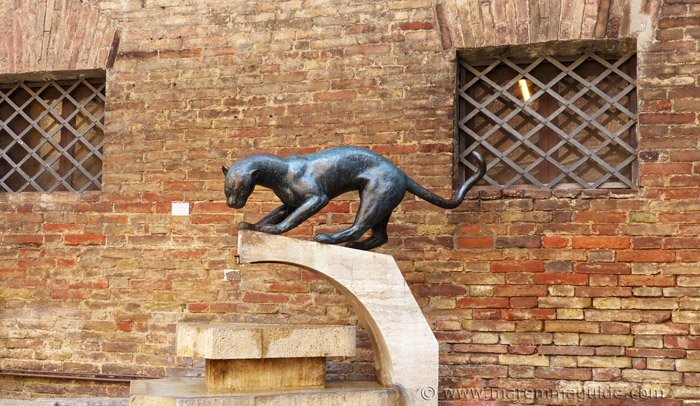


Then. When they have decided which Contrada they like the best, purchase the scarfs or flags of their chosen one. They are for sale everywhere. It will make the long wait and the race so much more interesting for them.
But be aware that, as I have mentioned above, children (and pushchairs and dogs etc) are forbidden in the spectator area in the centre of the Piazza del Campo. You will need to secure a seated watching place around the race track.
OR. Better still.

Take them the day before to the Prova Generale. Children are allowed into the spectator area in the centre of Piazza del Campo during the trials. And, a nice touch for them is that the long line of terrace seats that on race day are filled with medieval costumed bishops, dignitaries and contradaioli, are filled with children from the Contrade for the Prova Generale. Singing their lungs out against each other.
A wonderful sight and sound.
 The children of the Contrada della Torre
The children of the Contrada della Torre

Toilet facilities
The City of Siena doesn't lay on any additional bathroom facilities during the run-up to the race or on the days themselves.
So. Find a bar that you like and be prepared to drink more coffee, water, Prosecco! than you would normally in a day in order to frequent their bathroom. There is no other choice.
And, at the risk of sounding like I'm telling you how to suck eggs (or my mother!), take packets of tissues with you. Even those bars that do start out the day with their toilets stocked nicely, won't have time to keep them that way with all of the visitors in town. Enough said.
A NOTE for Mums. My favourite bar when I arrive in Siena is always the bar and pasticceria Nannini in the main thoroughfare, Via Banchi di Sopra. You can't miss it. It is the quintessential stop for a coffee or Prosseco, Italian-style. And has some of the best sweet panforte in town. If not the best. Although on Palio days it is well and truly more international with the number of visitors it receives.
My reason for mentioning it is that it's customer (not public!) toilets - downstairs - are much more spacious than most, well looked after, (still take those tissues though!), and have a lobby area with a fold-down changing table and a pay 'phone.
Best Siena palio websites
For an incredible amount of information that has been gathered with a passion and painstakingly preserved, visit the www.ilpalio.org website.
And the www.ilpalio.siena.it website.
Where to stay
For a Siena hotel with a balcony overlooking the Piazza del Campo try the stylish Residenza d'Epoca La Terrazza Sul Campo in the 14th century Palazzo Mattasala Lambertini.
It is the building in these photographs with the red draped terrace overlooking the straight part of the course in front of Palazzo Pubblico and the corner of the track at Curva del Casato.


The "extrador" Siena palio

And. If there is a really good reason to celebrate! The city will hold another Palio race - anytime between May and September: an "extrador palio".
Palio di Siena 2018
The Palio di Siena 2018 dates are Monday 2 July 2018 and Thursday 16 August 2018.
Tickets are already available for the stands, windows and balconies around the Piazza del Campo.
Explore some more...
